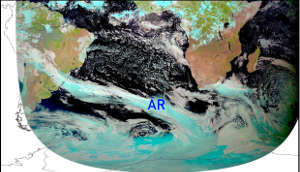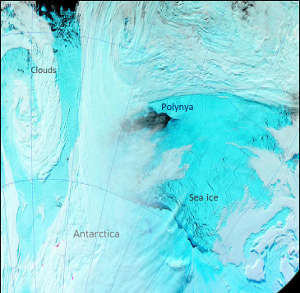Using AI to control energy for indoor agriculture
30 September 2024
Published online 11 November 2020
Streams of warm air flowing from tropical storm systems directly contribute to the melting of Antarctic sea ice.

EUMETSAT
The Weddell Polynya reopened in September 2017 after decades of being frozen over. It grew to a maximum size of 300,000 square kilometres, which is roughly the surface area of Italy. Diana Francis of Khalifa University of Science and Technology in the United Arab Emirates was intrigued by the potential contribution of atmospheric rivers: streams of warm air and water vapour generated by cyclone systems in the tropics.
Francis and her colleagues analysed detailed climatological data from the time surrounding the polynya’s formation, and identified a steady flow of atmospheric rivers in that area of sea ice in the preceding four days. “I was surprised to see an almost immediate melt in the sea ice covered by the atmospheric rivers during the coldest months of the year in Antarctica,” says Francis. A subsequent analysis of historic data revealed that a similar pattern unfolded in 1973, when the Weddell Polynya was first discovered by scientists.

NASA
This mechanism could also put the overall stability of the Antarctic sea ice in future jeopardy. “It is important to consider the projected increase in atmospheric river frequency and intensity in the Southern Ocean due to global warming,” cautions Francis. Accordingly, she and her colleagues are now planning a long-term study of how these atmospheric phenomena shape the Antarctic icescape.
Michiel van den Broeke of the University of Utrecht sees the work as an interesting and original perspective on a confounding mystery, but adds “it is likely not the final answer to the Weddell Polynya formation conundrum,” and that additional, more sophisticated models will be needed to arrive at a more definitive explanation.
doi:10.1038/nmiddleeast.2020.120
Francis, D. et al. On the crucial role of atmospheric rivers in the two major Weddell Polynya events in 1973 and 2017 in Antarctica. Sci. Adv. 6, eabc2695 (2020).
Stay connected: